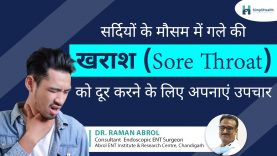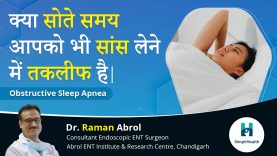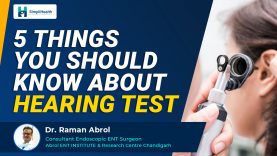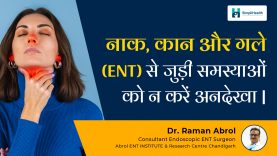Types of Hearing Test | Prevent Hearing Loss | ENT Clinic Chandigarh | ये टेस्ट होते हैंजब आप सुन नहीं सकते | बहरापन कम सुनाई देने का इलाज
- 1.24K
- 3 years ago
Dr. Raman Abrol
Dr. Raman Abrol
Types of Hearing Test | Prevent Hearing Loss | सुनने की शक्ति बढ़ाने के लिए क्या करना चाहिए? | कान से कम सुनाई दे तो क्या करें?
Types of hearing test, In this video SimpliHealth expert, Dr. Raman Abrol will be talking about hearing tests in adults.
What are the types of hearing tests for adults?
For adults, we have standard tests which are done for hearing, which is called Pure-tone audiometry. And this test involves the response from the patient. The sounds are given to the patient, and the patient has to tell us whether he is able to hear or not. In this, we test the whole range of the sound in all hertz (unit of sound). When all range of sound with each frequency is done on the patient, a very detailed graph is made after the test. This is a standard test for adults who can respond well.
What are the hearing tests for toddlers?
Behavior Audiometry
For toddlers and infants since their response is not reliable so we have to do certain tests where their involvement is least. For the children who are a little older and can respond, we do something called Behavioral Audiometry, where we give some sounds to the patient and see the behavior of the patient. Judging by the behaviors of the child we can say that this is the sound that the child is able to hear or is not able to hear. This is called Behavior Audiometry.
This is not a very exact test, but then we have a broad judgment and idea about the patient’s hearing.
Brain Evoked Response Auditor | Types of Hearing Test
The other test which can be done is where the patient’s involvement is not required at all, which is done for infants and for very small children it is called BERA (Brain Evoked Response Auditor). In this certain electrodes are put on the head of the child. And the child is put to sleep. And through these electrodes, we convey sounds in form of electrical impulses and we pick up the changes in the brain in response to the hearing. It is called BERA. So this is done for infants are inform people who cannot respond and who don’t know what is going on.
Otoacoustic Emissions | Types of Hearing Test
So there are two types of tests which are used. And then there is another one which is called Screening in the children or infants, premature babies for which BERA is also one, but it is a more detailed test.
There is a bedside screening called Otoacoustic Emissions. These are the brain waves which are collected from the ear of a premature baby or the infant and there is a small machine which can be carried to the ear, and it picks up the brain the waves of the sound from the inner ear. It’s called Otoacoustic Emissions.
So for infants and children, there are three tests that are done.
What is the importance of a hearing test?
- Old age: Hearing tests are important for anyone who has deafness for any cause, like old people who have deafness, which is natural and is called Presbycusis. Old people who have some kind of hearing loss need assessment.
- Ear Infection: And also the people who have some ear problem like discharging ears or infections, etc. all of them need a hearing test.
- Occupation: And also in certain professionals who are exposed to a lot of noise, who is involved with the construction industry or instrumentation, are exposed to a lot of noise. They need yearly checkups to see whether there is any harm caused to the ears.
How frequently should one get a hearing test?
If the patient has no problem at all then, he doesn’t need to get them regularly but once in a while, maybe in 2-3 years, he can get them done. But the people who were exposed to noise and loud sounds, as a rule, must get their ears tested once a year.
How to prepare for a hearing test?
Adults
There is no specific preparation for adults. Just walk into a hearing test chamber or visit an ENT doctor and get this done. This takes about 5 minutes. An audiometry test does not take more than 5 mins.
Children
Children who need this test for hearing need 3-4 preparations in a nutshell. The first is conditioning. Because in Behaviour Audiometry we condition the child that in response to the sound he has to do some action. Because the child may not understand how to raise a finger or raise an arm or anything. But to get a reaction, we first condition the child. After 1-2 sittings, that in response to this certain sound you have to do certain actions. So this is conditioning.
The other thing is that for the BERA or Otoacoustic Emissions there are certain preparations to be done. Like the patient has to be put to sleep also the patient should not have oiled hair or oiled head so that the electrodes can be stuck on them. So these are the things that the patient needs to prepare.
What are the machines and gadgets used for hearing tests?
For adult audiometry, it is a standard gadget called a pure tone audiometer, and it conveys the sound of various frequencies at various loudness levels to the patient’s ear through a headphone. So it’s the headphone that receives the sound from outside the machine. The audiometer is outside the chamber, and the patient is in the soundproof chamber and the sound is delivered through headphones into the patient ear. If the patient is listening, he will respond by raising the figure. It’s a standard pure tone audiometer that is used for this.
But for children, it’s special equipment called BERA. BERA equipment is special, and there is another hour special equipment as a normal pure tone audiometer cannot be used for children.
Preventive measures for better hearing
Actually, there are certain dos and don’ts. There are certain things that we do not advise the patient. Like for children, we say listening to loud music in the earphones all the time for many hours in a day should be avoided. The people who are in the music industry, who are in studios, or who are exposed to sound all the time like DeeJay, etc. all these people are advised to limit their hours of sound exposure. They must use muffills as long as much as possible, especially the industrial workers which mask the ears to prevent sound. But in the music industry probably is not that possible because they have to hear what they are doing, so for them, it’s important that they get periodical checkups. These checkups must be strictly done, and preventive measures to be taken if they see something wrong.
Also, excessive phone use. The people who use their phones all the time like 4,5, 6, 7, or 8 hours every day for many years, would get some changes in their hearing over a period of time so they must also avoid continuous phone use.
Doctors advice
I must say that ear diseases are not uncommon in society. But the problem is it’s a neglected area. A lot of people don’t pay heed to the problems that they are having in their ears. A lot of people who have dirty wax, a lot of dirty discharges, they have problems, they self-medicate and self-clean and do a lot of things which should be done by a trained professional. And if there is any problem happening to the ears, they should approach an ENT specialist rather than self-medicate. Thank you.















Comments (0)